The Russian capital of Moscow is one of history’s great cultural and political centers. With its 15 million citizens, it is Europe’s largest city, and there are countless major sights, prestigious museums, fine monuments and exciting attractions.
The adventure starts in the heart of Moscow, where the colorful onion domes of St. Basil’s Cathedral adorn the center of the Red Square in front of the Kremlin’s impressive towers, spiers, cathedrals and fine museums. Much of the architecture dates from Russia’s time with czarist rule, but there are colossal monuments from the superpower times of the Soviet Union.
So much to see in the city, and so much below ground as well. Moscow’s subway, which is arguably the most beautiful in the world, is famous for the old stations which are built like palaces or with elegant stylistic reference to the station’s names. This is a unique sights as so much else in the Russian capital.
In Moscow there are also beautiful monasteries and parks like Soviet VDNKh, and here are places like the Museum of Russia’s cosmonauts and UNESCO World Heritage Sites like the white church in Kolomenskoye. A bit further out of town, there are many cultural cities with unforgettable sights like Sergiyev Posad.
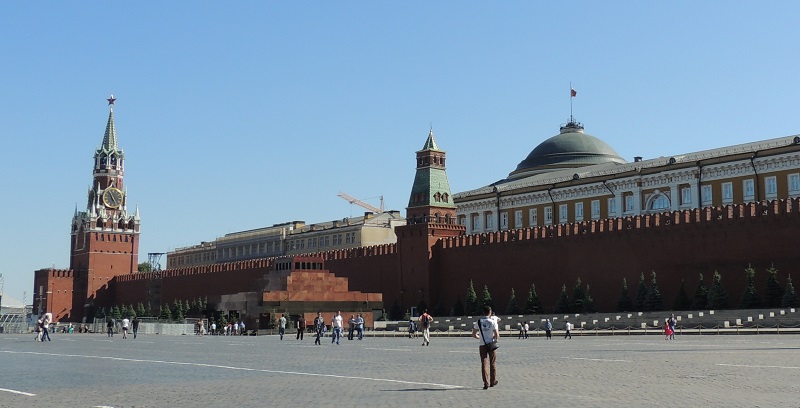
The Red Square is one of the most beautiful and famous squares in the world. It is the center of Moscow, and is home to famous buildings such as the Kremlin, GUM, St Basil’s Cathedral, Kazan Cathedral and Lenin’s Mausoleum.
Lenin was the Soviet leader in the eraly Soviet Union. His mausoleum was built in the middle of Red Square for the world to see him as a symbol of Soviet power. Behind the mausoleum itself you can see a number of other tombs, where i.a. Stalin and Yuri Gagarin are buried.
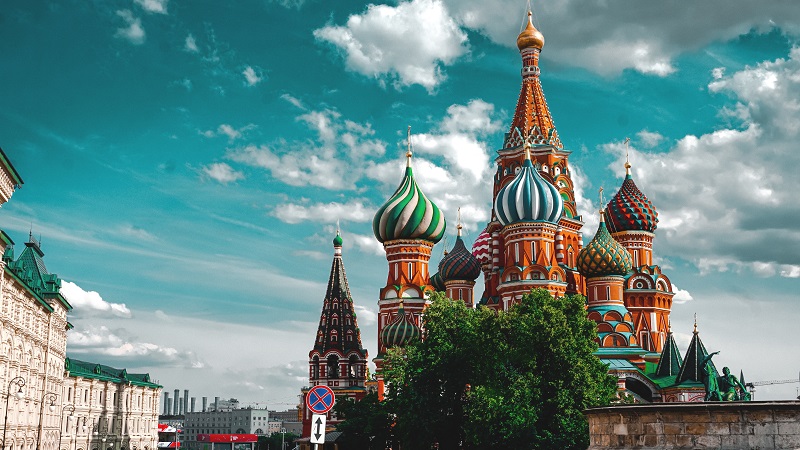
This is the iconic church on Red Square with its colorful bulbous domes. The cathedral was built in 1555-1561 and consists of many small churches built beautifully together around the central main church.
The Kremlin is Moscow’s ancient fortified city, and it forms the center of the Russian capital. Today, the Kremlin is the political center of the country, and behind the red walls you can see some of the most important churches of the Russian Orthodox Church.
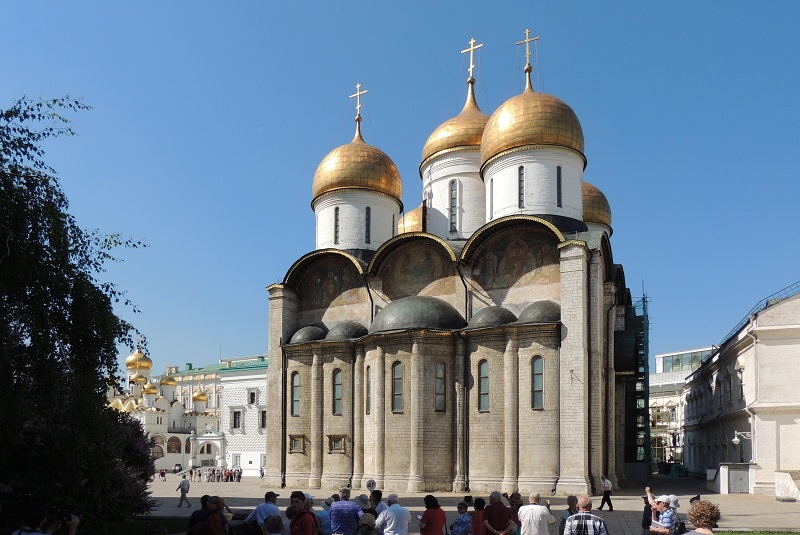
This cathedral is and has been one of the most important churches in all of Russia. The present church is beautifully decorated in its interior and was built 1475-1479. The church was for centuries the coronation church of the Tsars.
This cathedral from 1505-1508 was the Tsarist burial church until Peter the Great moved the court from Moscow to St. Petersburg. That is why there are monuments to a number of tsars here.
In the buildings of the Kremlin you can see the armoury chamber, which is a fantastic museum with jewelry, weapons and collections from the Tsars’ personal property. Here are i.a. Fabergé eggs and the throne of Ivan the Terrible.
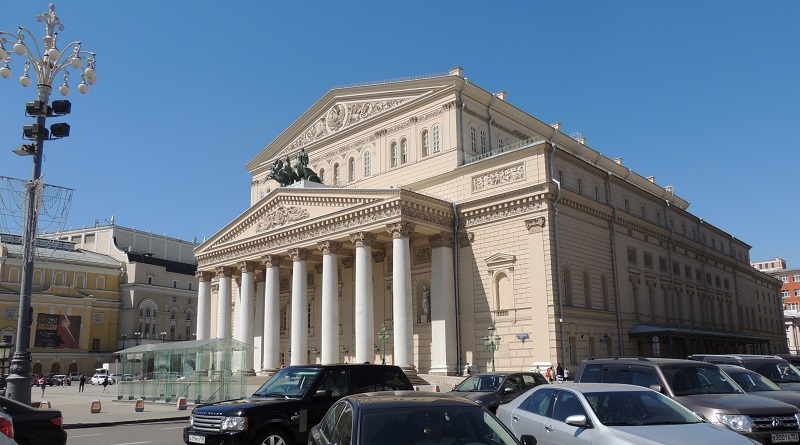
Moscow’s Bolshoi Theater was built in 1854, and its name means The Great Theater. Today, the place is known as one of the world’s great and famous stages with beautiful performances.
Tretyakov Gallery is almost a must for all art lovers on a visit to Moscow. It houses one of the world’s finest collections of Russian art. You can see icons and other art up to the 20th century.
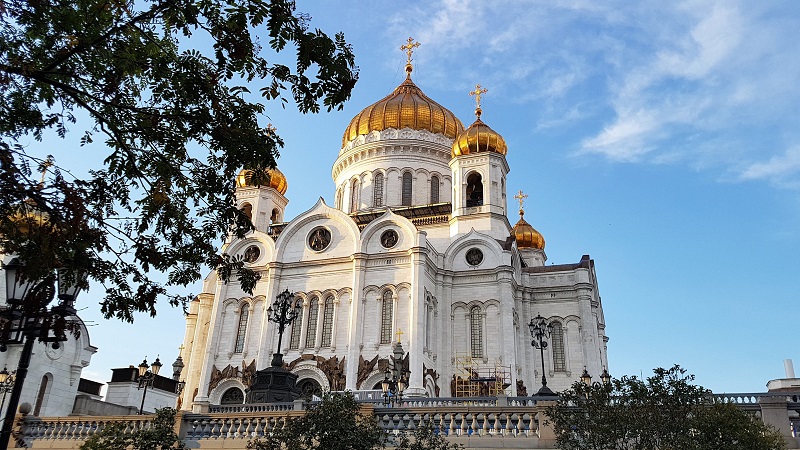
With its 105 meters/345 feet, the Cathedral of Christ the Saviour is the tallest Russian Orthodox church in the world. The magnificent church was built as a memorial church for Russian victims in the war against Napoleon.
This is the most famous of Moscow’s monasteries. It was founded by Tsar Vasily III in 1524. The monastery complex stands beautifully in so-called Moscow Baroque architecture. Next to the monastery you can visit one of Russia’s most famous cemeteries.
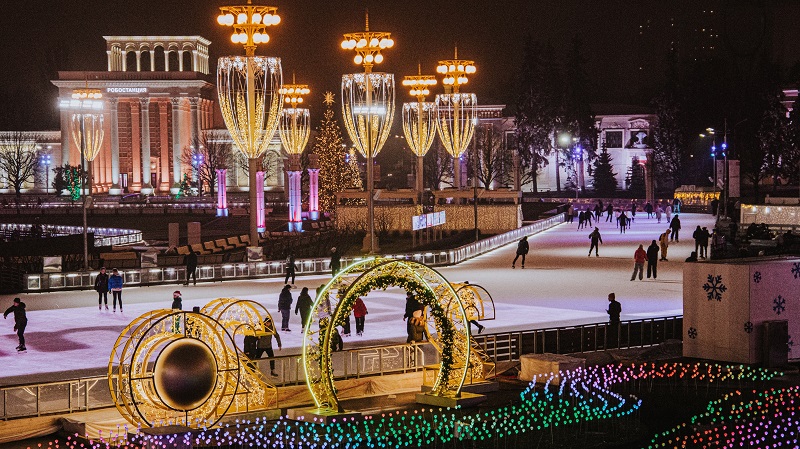
VDNKh is the name of a unique exhibition park built in Stalin’s Soviet Union. The park was supposed to be an exhibition of the country’s achievements and you can still see beautiful pavilions and exciting exhibits today.
This is one of the most famous statues found anywhere in the former Soviet Union. It was built in the style of socialist realism. It was Vera Mukhina who designed the iconic statue for the 1937 World’s Fair in Paris.
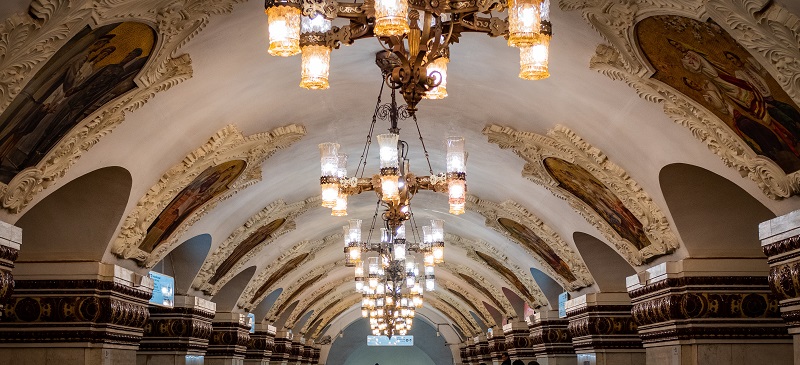
The metro in Moscow is without a doubt the most beautiful in the world with the many stations built as the palaces of the people. On a tour underground, be sure to see Mayakovskaya and Komsomolskaya stations.
The Church of the Resurrection is the oldest preserved building in Kolomenskoye and is a UNESCO World Heritage Site. The church was built in 1532 as a monument to the birth of the later Ivan IV.
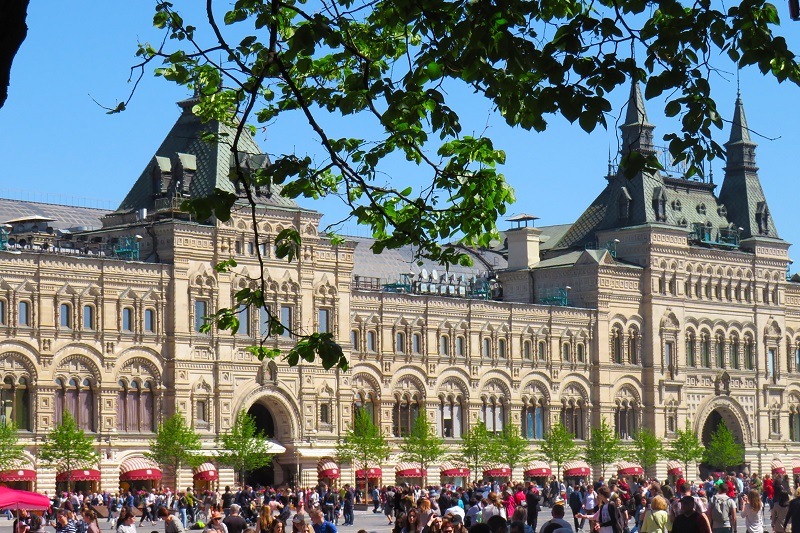
GUM is the colossal department store on The Red Square. The large shopping center was built 1890-1893 on the site that was formerly a marketplace. GUM is a beautiful building and with several inner streets with countless shops. You can also visit one of the original toilets from 1893.
At this museum you can experience the magnificent story of Russia’s long and exciting history. Here is archeology, furniture, crafts, etc. within many themes.
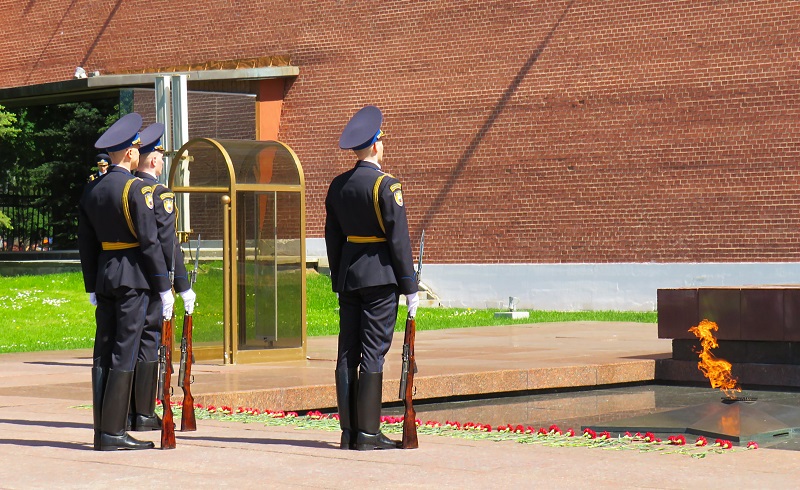
Alexander Garden is a lovely park laid out in 1823 along the western wall of the Kremlin. Today you can see a number of fine plantations and memorials to several wars and fallen soldiers. There is also an interesting change of guards to be seen.
Lubyanka was the daily name of the KGB headquarters in Soviet times. The large building dominates the central square, and it is today the headquarters of the FSB, which replaced the KGB.
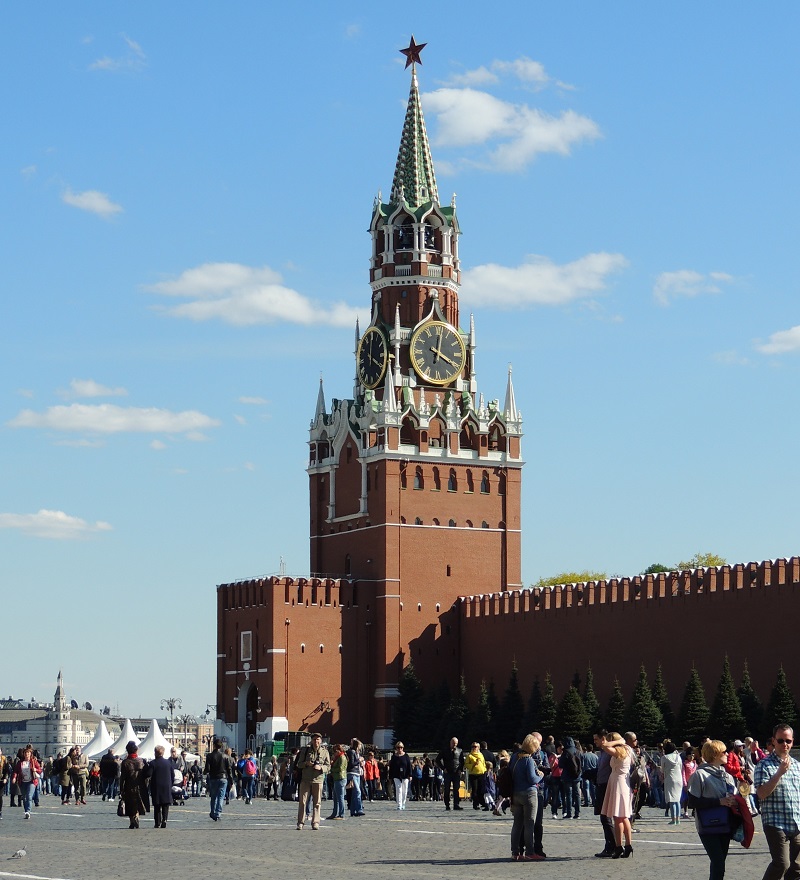
Along the walls of the Kremlin there are several defense towers, and the Saviour Tower is perhaps the most interesting. With its 71 meters/232 feet, it is one of the highest of them all, and it is beautifully located facing the Red Square.
Zaryadye Park is a large and modern park, which opened on September 9, 2017 in one of Moscow’s absolute best locations right next to the Kremlin and Red Square. In the park there is a spectacular walkway over the Moscow River.
The Romanov family was on the Russian throne from 1613 until the fall of the dynasty in 1917. This mansion was the residence of the Romanov family in Moscow, and it has been a museum since 1859.
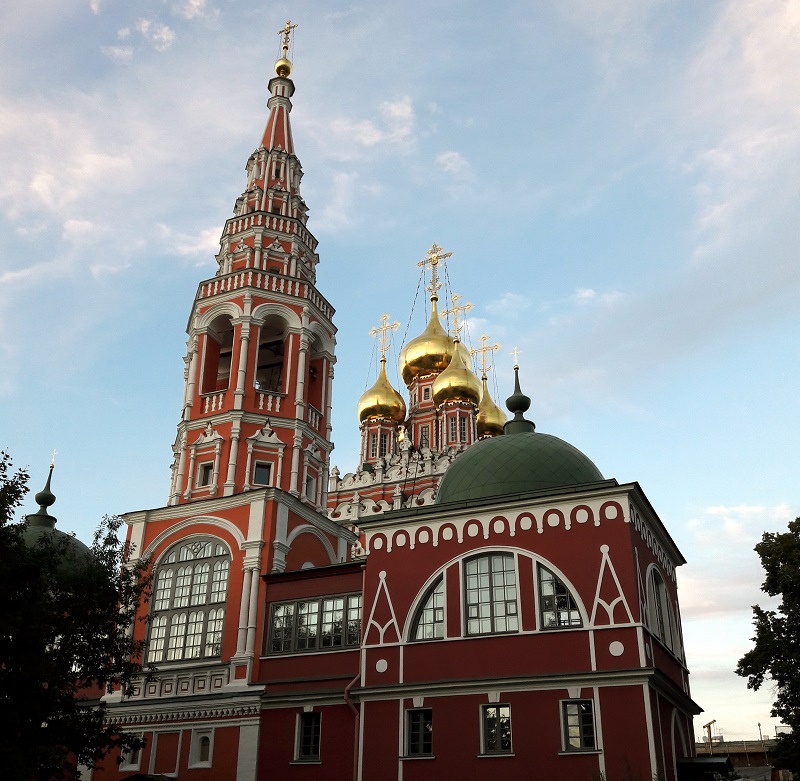
Zamoskvorechye is a cozy neighborhood located south of the Moscow River. Just a few minutes walk from The Red Square, there are streets here with low-rise buildings, fine small churches and an almost provincial atmosphere.
Pushkin is Moscow’s leading art museum for international art. You can see works by masters such as Monet, Gauguin and Rembrandt at this interesting museum, which is a must for art lovers.
Arbat Street is Moscow’s busiest pedestrian street, and it is known throughout Russia as one of the places to take a stroll when in the capital. There is always a good atmosphere, nice shops and good restaurants here.
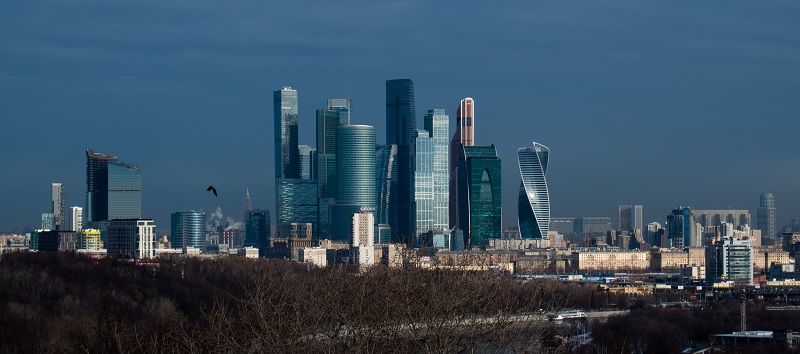
This is a modern high-rise neighborhood west of downtown. There are several impressive skyscrapers, of which the winding Evolution Tower is most fascinating in its architecture.
Hotel Ukraine is a luxurious hotel and one of Stalin’s seven sisters, which is the name of the high-rises in Stalin’s Gothic architecture. In Hotel Ukraine you can see the famous diorama from Moscow in 1977 and the hotel’s beautiful interior.
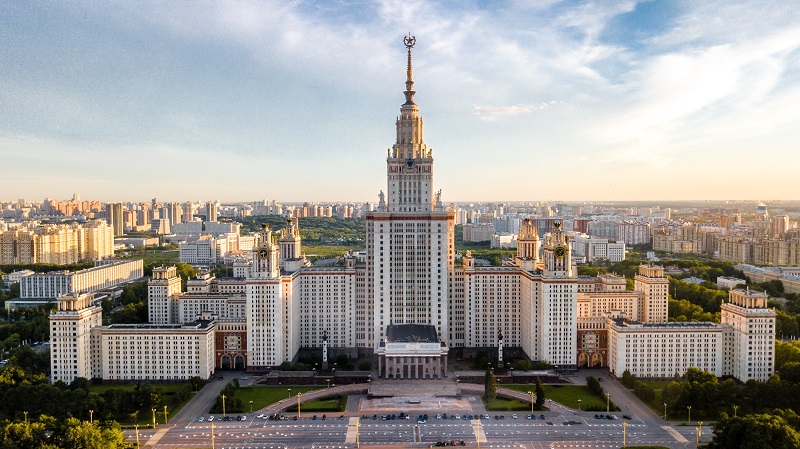
In Moscow you can see seven high-rise buildings from Stalin’s time. These are the so-called Seven Sisters, and of these, Moscow State University with its 240 meters/787 feet is the highest. From the area in front of the university there is a beautiful view of the city.
Ostankino TV Tower was built 1963-1967 as the world’s tallest building with an impressive 540 meters/1,771 feet in height. There is an observation deck at 337 meters/1,105 feet with an unforgettable view.
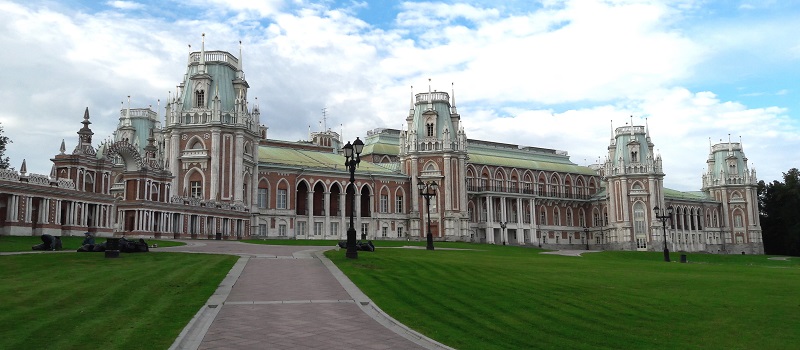
Tsaritsyno is a large lovely park with lakes, fountains, green areas and not least the palace of Catherine the Great, named Tsaritsyno after the title of the zarina.
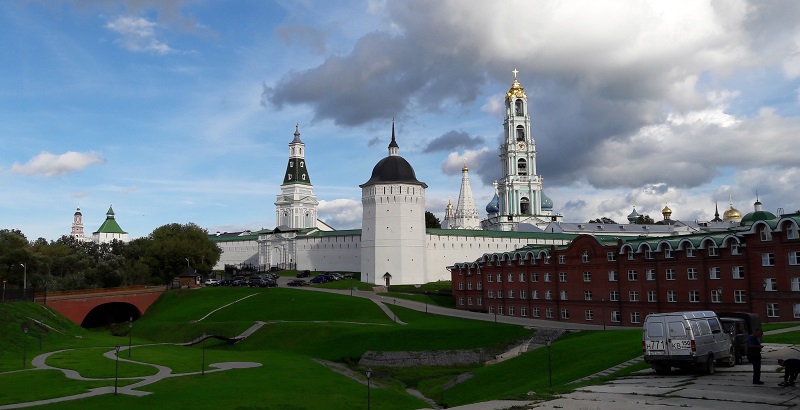
Sergiyev Posad is Russia’s former religious capital, and the site offers a good insight into the rich and beautifully decorated medieval architecture. The city’s biggest attraction is the unforgettably beautiful Trinity Lavra of St Sergius, a UNESCO World Heritage Site.
The old city of Vladimir is famous for its two cathedrals, which are among the most beautiful in the country. The 12th-century Dormition Cathedral is one of the ecclesiastical highlights of the city, where you can also enjoy the Golden Gate, which is also from the 12th century.
The relatively small town of Suzdal houses a multitude of churches and monastery buildings. With typical onion domes and other ornate constructions, Suzdal is very worth seeing. The most visited place in the city is the central castle complex, the Suzdal Kremlin, whose history dates back to 1024.
The history of the city of Kostroma dates back to the 1100s-1200s, and there are many sights in the city. Kostroma also played a special role for the Romanov family, as Mikhail Romanov was in a monastery right here when he was offered the Russian throne in 1613. You can still see Ipatievsky Monastery, where Mikhail Romanov was at that time.
Lubyanka/Лубянка
www.detmir.ru
Bagrationovskij pr. 7/Багратионовский пр. 7
www.gorbushkin.ru
Krasnaja ploshad 3/Красная площадь 3
www.gum.ru
Several addresses in Moscow
www.megamall.ru
Manezhnaja ploshad 1/Манежная площадь 1
www.okhot-ryad.ru
Petrovka 2/Петровка 2
www.tsum.ru
Streets around Arbat/Арбат, Novyj Arbat/Новый Арбат and Tverskaja ulitsa/Тверская улица
Gorky Park/Центральный парк им. М.Горького
Krymskij val 9/Крымский вал 9
www.park-gorkogo.com
Memorial Museum of Cosmonautics/Мемориальный музей космонавтики
pr. Mira 111/пр. Мира 111
www.space-museum.ru
Moscow Dolphinarium/Московский дельфинарий
ul. Mironovskaya 27/Ул. Мироновская 27
Moscow State Circus/Большой Московский государственный цирк
Prospekt Vernadskogo 7/Проспект Вернадского 7
www.bolshoicircus.ru
Moscow Zoo/Московский зоопарк
ul. B. Gruzinskaja 1/ул. Б. 1рузинская 1
www.zoo.ru/moscow
Ostankino TV tower/Останкинская башня
ul. Akademika Koroljova 15/ул. Академика Королёва 15
www.tvtower.ru
In the 8th century, the river Oka was used as a trade route, and the area around the upper part of Volga became a meeting place for various tribes such as Germans, Indians and the slaves who came to inhabit the places.
Actual settlements in the large area between the Volga and Oka rivers are believed to be established in the 1000s; in the central part of present-day Moscow was a small village around the year 1100.
Moscow’s official foundation was in 1147, when Jurij I Dolgorokij, prince of Suzdal, met here with a prince from Novgorod. The meeting brought the village, located in the western part of Vladimir-Suzdal, into the history books.
In 1156, Jurij Dolgorokij expanded and fortified the city by establishing a moat and the first wooden defenses.
The Asian Mongols ravaged and conquered vast land masses during the 13th century, and their advance and subsequent administration had consequences for the entire East Slavic area that has become present-day Russia, Belarus and Ukraine.
In 1237-1238, the grandson of Genghis Khan, Batu Khan conquered Vladimir-Suzdal, under which Moscow belonged. The capital Vladimir and Moscow itself were burnt, and the Mongols built their new capital Saray to the south. They even became known as the Golden Horde.
The internal Russian battles under the Mongols supremacy were important to which cities and regions flourished. In 1283, Moscow became a prince with Daniel as the first prince.
The cities of Moscow and Tver were some of the beneficiaries of economic prosperity, but in 1327 Tver’s prince joined the rebellion against the Mongols. Moscow Prince Ivan I joined the Mongols, destroying Tver and thereby one of the city’s competitors in the region.
The rival Tver had fallen, and Moscow was now able to attract and establish the Russian Orthodox Church’s headquarters in the city. Ivan I was also given the title of Grand Duke of the Mongols, which meant a greater status and power than before.
While the Mongols continued to ravage on a regular basis in the Russian territory, Moscow, as a partner, enjoyed relative peace and freedom. The ruler of the city was used as part of the Mongols and other Russian peoples and states, and the peace with the Mongols prompted many prosperous people to move to Moscow, which grew.
Moscow, with its economically significant river trade, had the opportunity to form an independent city state. However, the city state continued to pay money to the Golden Horde well into the 15th century, when Prince Ivan the Great increased Moscow’s power and sphere of influence considerably.
With victories over other Russian princes, Moscow was able to expand its territory through the same century. Novgorod was conquered in 1478 and Tver fell seven years later. At the end of the 15th century, Ivan III, nicknamed the Great Kingdom, stretched to Novrogod to the northwest, the Barents Sea to the north, Ural to the east and Tula to the south. Ivan, for good reason, called himself the entire ruler of Russia, and he called on Italian architects to expand the central power base, the Kremlin, with cathedrals, among others. It was also during Ivan III that the Red Square was built.
By this time, most of the ethnic Russian territory was thus gathered and strengthened, and the Mongols had begun their final retreat after the Battle of Ugra, which despite its name never developed into a real battle.
Moscow’s defense was continually strengthened over the following centuries; for example, the boroughs of Murbyen / Китай-город, the White City / Белый город, and the City of Earth / Земляной город were established as a kind of circular defense around the Kremlin.
However, attacks and destruction also occurred. In 1547 a large part of the city burned, and in 1571 the Crimean Tatars plundered the city, which was again burnt down; only about 30,000 of the city’s 200,000 were left after that.
From Moscow, Ivan increased the sphere of cruel Moscow with the colonization of Siberia. It infected Moscow, which had a population of more than 200,000, making it one of the world’s largest cities.
Between 1584 and 1591, a city wall was constructed and it quickly proved useful. The Crimean Tatars attacked again in 1591, but this time the fortifications could hold them back. The following year, the defense was expanded again with an external earth tower with 50 towers. The location of the earthviolence can now be seen on a city map, as the ring road Garden Ring/Садовое кольцо is now here. Outside the violence, several fortified monasteries lay as southernmost hedges.
Boris Godunov was prime minister and later czar around the year 1600, and the city was then hit hard times. First, a severe famine struck in 1602-1603, and then troops from Poland-Lithuania came and occupied the city in 1610. It took two years before a rebellion led to their defeat and retreat.
The hardships were not over with that. In 1626 and again in 1648, large parts of the city’s many wooden houses burned, and in the years 1654-1655 the majority of Moscow’s inhabitants died in the plague epidemic that hit.
Meanwhile, the Romanov dynasty had been established as tsars. It began with Mikhail Romanov in 1613, and the dynasty sat on the Russian zartrone right up to the Bolshevik political upheaval in 1917. With Mikhail Romanov’s accession, Moscow, despite fires and plagues, entered a time when the city was once again flourishing, and the kingdom was expanding continuously. to the south.
Zar Peter the Great traveled around Europe 1697-1698, and it became of great importance to Moscow. The Czar founded St. Petersburg in 1703, and the Russian capital was moved from Moscow to the new city, taking over Moscow’s role as the politically and culturally dominant city in the kingdom.
The Russian nobility built mansions in the new capital, and from a size of about 200,000 inhabitants, that number dropped to about 150,000 in the mid-18th century.
However, the declining population did not continue, as Moscow’s considerable size and economic importance was maintained over time, and the number of citizens again began to rise rapidly.
In the reign of Peter the Great, Moscow’s streets were being paved, permanent street lighting was introduced in 1730, and 25 years later, the city’s university was founded. Although the capital was in St. Petersburg, the city’s defense was also expanded.
Moscow’s status was no longer capital, but its importance to Russia was emphasized by its being French Napoleon’s invasion target.
The French troops achieved massive advances through Europe and the large Russian territories. In 1812 the decisive battle was fought; it took place at Borodino 130 kilometers west of Moscow and was on Napoleon’s road towards the city.
Here 44,000 Russian soldiers and 35,000 French were killed. After the battle, the Russians withdrew and Napoleon was able to take Moscow. Instead of the czar’s surrender and negotiation for peace, the city was evacuated and partially burned. Napoleon and the French forces left the city within a month.
A great deal of construction work was carried out following Napoleon’s siege and short-term conquest of Moscow, and the city’s population quickly rose rapidly as the 19th century began industrialization, which brought with it new districts and city plans.
The railways’ entry into the Russian metropolis also gained momentum throughout the century. Several railway stations were built on the periphery of the city center, and with the Trans-Siberian Railway one could get from Moscow to eastern Russia on the Pacific coast.
Up to the early 1900s, political decisions continued to be made by the Tsars in the capital of St. Petersburg, but tensions in the country and in Moscow increased over the years, and it ended with a revolution.
During the October 1917 Revolution, Moscow was the Russian city, with the most fighting in the streets. The Kremlin was occupied by the communist Bolsheviks and the revolutionary hero and communist leader Vladimir Lenin decided to move the capital from Petrograd (Saint Petersburg) to Moscow. He aligned himself with his government in Moscow, and it marked the beginning of Moscow’s next heyday as one of the world’s most important political centers.
Moscow became the center of the whole country and part of the world reorganization. Moscow itself, under Josef Stalin, was subject to the most comprehensive urban planning of world history. The boulevards, institutions and countless new residential neighborhoods were built and linked by the world famous metro, whose first line opened in 1935.
Germany invaded Russia in 1941, and the German troops reached the outskirts of Moscow. Only 40 kilometers from the city, they were stopped by Russian resistance – and the cold Russian winter, which had also caused Napoleon problems.
After World War II, Moscow was expanded with colossal new residential areas and large-scale buildings, following Stalin’s desire to show Soviet ability in the form of a monumental capital, if none existed.
The city’s population increased significantly, as did the city’s importance throughout the Soviet Union. From a population of 1.8 million at the time of the revolution in 1917, the city grew million by million, and today it is Europe’s largest city.
Following President Mikhail Gorbachev’s glass nest in the 1980s, Boris Yeltsin went on the barricades in 1991 and established Moscow as the new Russia’s capital, which in recent years has been a city with a great deal of investment in new buildings as well as maintenance of monuments for the city’s historic events.
The whole story is represented from the buildings of the princes, the elegance of the tsars, the monumental grandeur of the Soviet Union and today’s ambitious and forward-thinking Russia.
All over the city you will find prosperity, shopping opportunities, good food and attractions, of which the many inhabitants are large consumers.
Overview of Moscow
The Russian capital of Moscow is one of history’s great cultural and political centers. With its 15 million citizens, it is Europe’s largest city, and there are countless major sights, prestigious museums, fine monuments and exciting attractions.
The adventure starts in the heart of Moscow, where the colorful onion domes of St. Basil’s Cathedral adorn the center of the Red Square in front of the Kremlin’s impressive towers, spiers, cathedrals and fine museums. Much of the architecture dates from Russia’s time with czarist rule, but there are colossal monuments from the superpower times of the Soviet Union.
About the upcoming Moscow travel guide
About the travel guide
The Moscow travel guide gives you an overview of the sights and activities of the Russian city. Read about top sights and other sights, and get a tour guide with tour suggestions and detailed descriptions of all the city’s most important churches, monuments, mansions, museums, etc.
Moscow is waiting for you, and at vamados.com you can also find cheap flights and great deals on hotels for your trip. You just select your travel dates and then you get flight and accommodation suggestions in and around the city.
Read more about Moscow and Russia
Buy the travel guide
Click the “Add to Cart” button to purchase the travel guide. After that you will come to the payment, where you enter the purchase and payment information. Upon payment of the travel guide, you will immediately receive a receipt with a link to download your purchase. You can download the travel guide immediately or use the download link in the email later.
Use the travel guide
When you buy the travel guide to Moscow you get the book online so you can have it on your phone, tablet or computer – and of course you can choose to print it. Use the maps and tour suggestions and you will have a good and content-rich journey.
Kremlin • GUM • Lenin • Beautiful Churches • Fine Museums • The Red Square
Overview of Moscow
The Russian capital of Moscow is one of history’s great cultural and political centers. With its 15 million citizens, it is Europe’s largest city, and there are countless major sights, prestigious museums, fine monuments and exciting attractions.
The adventure starts in the heart of Moscow, where the colorful onion domes of St. Basil’s Cathedral adorn the center of the Red Square in front of the Kremlin’s impressive towers, spiers, cathedrals and fine museums. Much of the architecture dates from Russia’s time with czarist rule, but there are colossal monuments from the superpower times of the Soviet Union.
About the upcoming Moscow travel guide
About the travel guide
The Moscow travel guide gives you an overview of the sights and activities of the Russian city. Read about top sights and other sights, and get a tour guide with tour suggestions and detailed descriptions of all the city’s most important churches, monuments, mansions, museums, etc.
Moscow is waiting for you, and at vamados.com you can also find cheap flights and great deals on hotels for your trip. You just select your travel dates and then you get flight and accommodation suggestions in and around the city.
Read more about Moscow and Russia
Buy the travel guide
Click the “Add to Cart” button to purchase the travel guide. After that you will come to the payment, where you enter the purchase and payment information. Upon payment of the travel guide, you will immediately receive a receipt with a link to download your purchase. You can download the travel guide immediately or use the download link in the email later.
Use the travel guide
When you buy the travel guide to Moscow you get the book online so you can have it on your phone, tablet or computer – and of course you can choose to print it. Use the maps and tour suggestions and you will have a good and content-rich journey.

GUM is the colossal department store on The Red Square. The large shopping center was built 1890-1893 on the site that was formerly a marketplace. GUM is a beautiful building and with several inner streets with countless shops. You can also visit one of the original toilets from 1893.
At this museum you can experience the magnificent story of Russia’s long and exciting history. Here is archeology, furniture, crafts, etc. within many themes.

Alexander Garden is a lovely park laid out in 1823 along the western wall of the Kremlin. Today you can see a number of fine plantations and memorials to several wars and fallen soldiers. There is also an interesting change of guards to be seen.
Lubyanka was the daily name of the KGB headquarters in Soviet times. The large building dominates the central square, and it is today the headquarters of the FSB, which replaced the KGB.

Along the walls of the Kremlin there are several defense towers, and the Saviour Tower is perhaps the most interesting. With its 71 meters/232 feet, it is one of the highest of them all, and it is beautifully located facing the Red Square.
Zaryadye Park is a large and modern park, which opened on September 9, 2017 in one of Moscow’s absolute best locations right next to the Kremlin and Red Square. In the park there is a spectacular walkway over the Moscow River.
The Romanov family was on the Russian throne from 1613 until the fall of the dynasty in 1917. This mansion was the residence of the Romanov family in Moscow, and it has been a museum since 1859.

Zamoskvorechye is a cozy neighborhood located south of the Moscow River. Just a few minutes walk from The Red Square, there are streets here with low-rise buildings, fine small churches and an almost provincial atmosphere.
Pushkin is Moscow’s leading art museum for international art. You can see works by masters such as Monet, Gauguin and Rembrandt at this interesting museum, which is a must for art lovers.
Arbat Street is Moscow’s busiest pedestrian street, and it is known throughout Russia as one of the places to take a stroll when in the capital. There is always a good atmosphere, nice shops and good restaurants here.

This is a modern high-rise neighborhood west of downtown. There are several impressive skyscrapers, of which the winding Evolution Tower is most fascinating in its architecture.
Hotel Ukraine is a luxurious hotel and one of Stalin’s seven sisters, which is the name of the high-rises in Stalin’s Gothic architecture. In Hotel Ukraine you can see the famous diorama from Moscow in 1977 and the hotel’s beautiful interior.

In Moscow you can see seven high-rise buildings from Stalin’s time. These are the so-called Seven Sisters, and of these, Moscow State University with its 240 meters/787 feet is the highest. From the area in front of the university there is a beautiful view of the city.
Ostankino TV Tower was built 1963-1967 as the world’s tallest building with an impressive 540 meters/1,771 feet in height. There is an observation deck at 337 meters/1,105 feet with an unforgettable view.

Tsaritsyno is a large lovely park with lakes, fountains, green areas and not least the palace of Catherine the Great, named Tsaritsyno after the title of the zarina.
Similar to Moscow Travel Guide